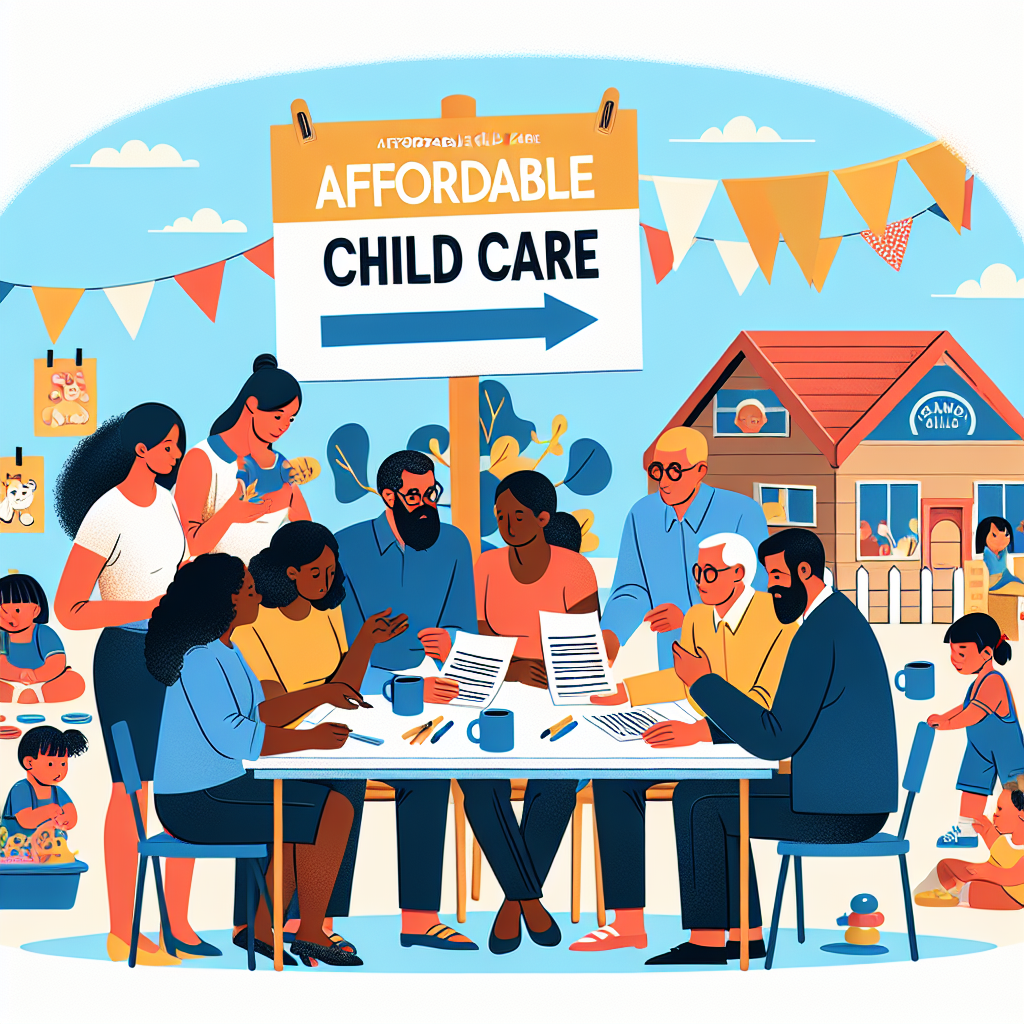Introduction
In today’s challenging economic landscape, Vice President Kamala Harris is stepping forward with a comprehensive set of proposals aimed at supporting middle- and lower-class Americans. Her initiatives focus on reducing living costs and empowering small businesses, which are the backbone of the U. S economy. The “Kamala Harris Small Business” agenda is designed to create opportunities for entrepreneurs while addressing the financial struggles that many families face.
Harris’s plans include a significant increase in the small business tax credit, expanding it from $5,000 to an impressive $50,000. This change could be a game-changer for startups, as it directly addresses the average cost of launching a new business, which is around $40,000. By reducing financial barriers, her proposals aim to inspire a new wave of entrepreneurship across the nation.
To illustrate the potential impact of these initiatives, consider the story of Maria, a single mother who dreams of opening her own bakery. Currently working two jobs to make ends meet, Maria often finds herself overwhelmed by the costs associated with starting her business. With Harris’s proposed tax credit and streamlined processes for obtaining loans, Maria could finally have the support she needs to turn her passion into a reality. Her story is just one example of how these economic proposals could transform lives and foster a thriving small business community.
As we delve deeper into Harris’s economic plans, we will explore how these initiatives not only aim to bolster small businesses but also seek to alleviate the financial pressures faced by countless Americans. Through targeted tax incentives and support for entrepreneurs like Maria, Harris is committed to building an economy that works for everyone.
2. Industrial Incentives
Tax Credits for Domestic Manufacturing: Boosting the Economy
Vice President Kamala Harris has unveiled a series of tax credits aimed at revitalizing domestic manufacturing. This initiative focuses on sectors such as biomanufacturing, aerospace, and advanced technologies. By providing financial incentives, Harris aims to encourage companies to invest in U. S production capabilities, ultimately fostering job creation and economic growth.
- Key Benefits of Tax Credits:
- Stimulates investment in critical industries.
- gives rise to “good union jobs” that benefit US laborers.
- Positions the U.S. as a leader in innovative manufacturing.
This approach not only addresses the immediate needs of the economy but also sets the stage for long-term sustainability. The focus on modernizing facilities aligns with Harris’s vision of a robust middle class, as she stated, “Building a strong middle class will be the defining goal of my presidency.”
Support for Union Jobs: Strengthening Workforce
Harris’s proposals also emphasize expanding “good union jobs” in traditional industrial sectors. By offering tax incentives specifically designed for unionized workforces, her plan seeks to ensure that workers benefit from economic recovery.
- Incentives for Union Jobs:
- Encourages companies to hire union workers.
- Promotes fair wages and benefits.
- Supports job security in manufacturing sectors.
This focus on union jobs is crucial for maintaining a stable workforce while enhancing the quality of life for American families.
Investment in Technology Research: Fueling Innovation
In addition to tax credits, Harris has committed to increasing funding for basic technology research through federal institutions. This investment aims to drive innovation and ensure that the U.S. remains competitive globally.
- Areas of Investment:
- Biomanufacturing
- Clean energy technologies
- Artificial intelligence and quantum computing
By prioritizing research and development, Harris’s agenda aligns with her commitment to fostering an environment where innovation can thrive.

Streamlining Infrastructure Projects: Cutting Red Tape
Harris plans to cut red tape associated with infrastructure and industrial projects. By streamlining permitting processes and utilizing the Defense Production Act, her administration aims to expedite the construction of critical projects.
- Benefits of Streamlined Projects:
- Faster implementation of essential infrastructure.
- Increased efficiency in project completion.
- Enhanced capacity to process critical minerals domestically.
This initiative not only supports immediate economic needs but also lays the groundwork for future growth by improving infrastructure capabilities.
Visual Infographic: Targeted Sectors for Investment
To summarize the key sectors targeted by these initiatives, refer to the infographic below:
| Sector | Focus Area | Expected Outcome |
| Biomanufacturing | Health and pharmaceuticals | Job creation, improved health outcomes |
| Aerospace | Aviation technology | Enhanced global competitiveness |
| Advanced Technologies | AI, quantum computing | Innovation leadership |
| Clean Energy | Renewable resources | Sustainable economic growth |
By focusing on these critical areas, Harris’s proposals aim to create a more resilient economy that benefits all Americans. The combination of tax credits, support for union jobs, increased research funding, and streamlined infrastructure projects represents a comprehensive approach to revitalizing American manufacturing.
3. Tax on the Wealthy
Promise Not to Raise Taxes on Lower Incomes: Protecting Middle-Class Families
Vice President Kamala Harris has made a clear commitment not to raise taxes on households earning less than $400,000 annually. This promise aims to reassure middle-class families that they will not bear the brunt of new tax policies. By focusing on the wealthy, Harris intends to create a fairer tax system that alleviates financial pressure on everyday Americans.
- Key Points:
- Protects middle-income households from tax increases.
- Focuses on wealthier individuals to fund public services.
- Aligns with Biden’s commitment to support the middle class.
This approach is designed to foster economic stability for families who are already facing rising costs in housing, healthcare, and education.
Endorsement of Biden’s Tax Hikes: Aiming for Equity
Harris has voiced her support for nearly $5 trillion in tax hikes over the next decade, which include a minimum tax on the wealthy. This endorsement aligns with President Biden’s fiscal agenda and aims to ensure that high-income earners contribute their fair share.
- Components of the Tax Hikes:
- corporation tax rate rise to 28% from 21%.
- Top individual income tax rate raised from 37% to 39.6%.
- Implementation of a 25% minimum tax on individuals with a net worth exceeding $100 million.
These measures are designed to address income inequality and generate revenue for essential public services. As Harris stated, “It’s time for the wealthiest Americans to pay their fair share.”

Capital Gains Tax Increase: Targeting High Earners
One of the most significant proposals is the increase in the long-term capital gains tax for high earners. Harris aims to raise this rate from 20% to 28% for individuals earning more than $1 million annually. This adjustment seeks to reduce disparities in how income is taxed and ensure that investment income is treated more equitably.
- Impact of Capital Gains Tax Increase:
- Encourages reinvestment in productive economic activities.
- Reduces incentives for wealth accumulation without taxation.
- Aligns capital gains taxation with ordinary income tax rates for high earners.
Harris believes that this change will help level the playing field for working-class Americans who do not benefit from capital gains.
Expert Opinions: Insights on Tax Changes
Economists have weighed in on the potential impact of these proposed tax changes. Many agree that increasing taxes on the wealthy could lead to more equitable economic growth while providing necessary funding for public services.
- Key Insights from Experts:
- Higher taxes on capital gains may discourage speculative investments but encourage long-term investments.
- The proposed minimum tax could generate significant revenue while ensuring that ultra-wealthy individuals contribute fairly.
- Overall, these changes could help reduce income inequality and support social programs aimed at benefiting lower-income families.
According to a report by the Tax Policy Center, implementing these tax hikes could significantly alter the fiscal landscape, providing much-needed resources for infrastructure, education, and healthcare.
Key Tax Proposals
| Proposal | Current Rate | Proposed Rate | Target Group |
| Corporate Tax Rate | 21% | 28% | Corporations |
| Top Individual Income Tax Rate | 37% | 39.6% | High-income earners |
| Long-term Capital Gains Tax | 20% | 28% | Individuals earning over $1 million |
| Minimum Tax on Wealthy | N/A | 25% | Individuals with net worth > $100M |
By focusing on these key areas, Kamala Harris aims to create a fairer tax system that supports middle-class families while ensuring that those with significant wealth contribute appropriately. Her proposals reflect a commitment to reducing inequality and fostering an economy that works for all Americans.

4. Tax on Businesses
Increase in Corporate Tax Rate: A Shift in Fiscal Policy
The proposal put forth by Vice President Kamala Harris is to increase the corporation tax rate from 21% to 28%. This move represents a partial reversal of former President Donald Trump’s tax cuts, aimed at ensuring that large corporations contribute their fair share to the economy. By increasing the corporate tax rate, Harris seeks to generate significant revenue that can be reinvested into public services and support for middle-class families.
- Key Points:
- The proposed increase aligns with President Biden’s fiscal strategy.
- It aims to address income inequality by ensuring that wealthier corporations pay their fair share.
- This adjustment is expected to generate approximately $1 trillion in federal revenue over the next decade.
This increase is not just a fiscal maneuver; it reflects a broader commitment to building an economy that prioritizes working families and small businesses.
Impact on Federal Revenue: Funding Essential Services
The estimated $1 trillion increase in federal revenue from raising the corporate tax rate could play a crucial role in funding essential services. This revenue would support initiatives aimed at making housing, food, healthcare, and childcare more affordable for American families.
- Potential Uses of Increased Revenue:
- Expanding the Child Tax Credit.
- Investing in infrastructure projects.
- Supporting small businesses through increased tax credits and reduced red tape.
By reallocating these funds, Harris aims to create a more equitable economic landscape where all Americans have access to opportunities for growth and success.
Comparative Analysis: Harris vs. Other Political Figures
When comparing Harris’s proposal to those of other political figures, it’s clear that her approach emphasizes fairness and equity. For instance, while Trump advocates for reducing corporate taxes further, Harris believes in increasing them to ensure that corporations contribute adequately.
- Comparison Table: Corporate Tax Rates
| Political Figure | Current Rate | Proposed Rate | Key Focus |
| Kamala Harris | 21% | 28% | Fair contribution from corporations |
| Donald Trump | 21% | Lower (proposed) | Business growth and relief |
| Joe Biden | 21% | 28% | Funding social programs |
Harris’s plan not only seeks to reverse the previous tax cuts but also aims to create a sustainable funding mechanism for essential public services. This contrasts sharply with Trump’s proposals, which focus on reducing taxes for businesses without addressing potential revenue shortfalls.
Integrating Financial Support for Small Businesses
As part of her broader economic agenda, Harris has also proposed significant support for small businesses. This includes expanding the small business tax credit from $5,000 to $50,000, helping entrepreneurs cover startup costs.
For entrepreneurs seeking financial assistance now, consider exploring options like this loan offer designed specifically for small business owners. These loans can provide crucial funding to help you launch or expand your business as you navigate the changing economic landscape.
Harris’s comprehensive approach recognizes that small businesses are vital to the U.S. economy, employing nearly all private-sector workers and driving innovation. By increasing corporate taxes on larger entities, she aims to create a more favorable environment for small businesses to thrive.

5. Child Tax Credit
Restoration of Enhanced Child Tax Credit: A Lifeline for Families
Vice President Kamala Harris has proposed a significant restoration of the Child Tax Credit (CTC), aiming to permanently increase the benefit from $2,000 to $3,600 per child under six years old. This change seeks to alleviate financial burdens on families by providing more substantial support during the critical early years of child development. The expanded CTC is designed to lift millions of children out of poverty and provide essential relief to middle-class families.
- Key Features of the Enhanced CTC:
- Increased credit for children aged 1 to 5: $3,600.
- Credit for children aged 6 to 17: $3,000.
- Fully refundable, allowing low-income families to benefit regardless of tax liability.
This proposal builds on the temporary expansion enacted during the pandemic, which demonstrated a significant impact by reducing child poverty rates. According to CBS News, the previous increase helped lift approximately 2 million children out of poverty.
Bonus for Newborns: Supporting New Families
In addition to restoring the CTC, Harris has introduced a one-time $6,000 bonus credit for families with newborns. This credit is structured to be received during the child’s first year, helping parents cover essential expenses such as diapers, clothing, and car seats.
- Benefits of the Newborn Bonus:
- Provides immediate financial relief during a critical developmental year.
- Supports young parents in managing unexpected costs associated with a new child.
Harris emphasized the importance of this support by stating, “That is a vital year of critical development for a child. The expenses can mount up quickly, particularly for newlyweds.”
Community Impact: Local Organizations Preparing for Change
Local organizations are gearing up to implement these changes and ensure that families can access the enhanced benefits effectively. Nonprofits and community groups are already working on outreach programs to educate families about the new CTC structure and how it can help them financially.
- Examples of Community Initiatives:
- Workshops on navigating tax credits and financial planning.
- Collaborations with local governments to streamline application processes.
- Advocacy efforts aimed at ensuring that low-income families are aware of their eligibility.
As Marisa Calderon, CEO of Prosperity Now, stated, “Both campaigns are showing big, bold proposals to give low-income and middle-income families tax relief that will raise literally millions of children out of poverty should they be enacted.”
Key Features of Harris’s Child Tax Credit Proposal
Key Features of Harris’s Child Tax Credit Proposal
| Feature | Current Amount | Proposed Amount | Age Group |
| Child Tax Credit | $2,000 | $3,600 | Children under 6 years |
| Child Tax Credit | $2,000 | $3,000 | Children aged 6 to 17 |
| Bonus for Newborns | N/A | $6,000 | Newborns |
By implementing these changes, Harris aims not only to provide immediate financial relief but also to create long-term benefits for families and children across America. The enhanced Child Tax Credit could significantly improve the quality of life for many households struggling with rising costs.
For families looking for additional financial support while navigating these changes, consider exploring options like this loan offer tailored for those in need. Such resources can help bridge gaps as families adjust to new financial realities.

6. Affordable Housing
Plans for New Construction: Building a Brighter Future
Vice President Kamala Harris has unveiled a comprehensive plan to tackle the affordable housing crisis in the United States. Her initiative aims to construct 3 million new housing units over the next four years, addressing the urgent need for affordable homes for renters and first-time buyers. By implementing tax incentives for developers, Harris seeks to spur construction and reduce living costs for families across the nation.
- Key Features of the Plan:
- Tax credits for builders focusing on affordable rentals and starter homes.
- Streamlined permitting processes to expedite construction.
- Increased funding for local housing initiatives.
This ambitious approach not only aims to alleviate the housing shortage but also strives to create sustainable communities where families can thrive.
Down Payment Assistance: Making Homeownership Attainable
To further support first-time homebuyers, Harris has proposed a $25,000 tax credit specifically designed for down payments. This assistance is particularly crucial for young families and individuals who may struggle to save enough for a down payment.
- Eligibility Criteria:
- first-time purchasers who have fulfilled their two-year rent obligations on schedule.
- Additional support for first-generation homeowners, those whose parents did not own homes.
This initiative will empower many families to achieve homeownership, providing them with a stable foundation and fostering community growth.
Innovation Fund for Housing: Investing in Local Solutions
Harris’s plan includes a $40 billion “Innovation Fund” aimed at encouraging local governments to develop affordable housing solutions. This fund will double the previous commitment made by the Biden administration and will focus on innovative financing methods and construction techniques.
- Goals of the Innovation Fund:
- Support local governments in creating sustainable housing projects.
- Foster collaboration between public and private sectors to address housing needs.
- Encourage creative solutions to reduce costs and increase supply.
By investing in local initiatives, Harris aims to empower communities to take charge of their housing challenges while ensuring that affordable options are available.
Future Projections: A Vision for Housing Stability
The successful implementation of these proposals could significantly enhance housing stability in communities across the country. With an increase in affordable housing units, families will have better access to safe and secure living conditions.
- Potential Impacts Over the Next Decade:
- A reduction in homelessness as more affordable units become available.
- Rental price stabilization as a result of greater supply.
- Enhanced economic mobility as families gain access to homeownership.
As Harris noted, “Affordable housing is a fundamental element of our opportunity economy.” By prioritizing these initiatives, her administration aims to create an environment where all Americans can thrive.
Key Features of Harris’s Affordable Housing Plan
Summary Table: Key Features of Harris’s Affordable Housing Plan
| Feature | Description |
| New Housing Units | Targeting 3 million units over four years |
| Down Payment Assistance | $25,000 tax credit for first-time homebuyers |
| Innovation Fund | $40 billion fund for local governments |
| Tax Credits for Builders | Incentives for affordable rentals and starter homes |
By focusing on these key areas, Harris’s proposals aim not only to address immediate housing needs but also to create long-term solutions that benefit communities across America.
For those looking to navigate the challenges of homeownership or seeking additional financial support, consider exploring options like this loan offer tailored specifically for first-time buyers and families looking to invest in their future. Such resources can provide essential funding as you embark on your journey toward homeownership.

7. Small Business Tax Credit
Increase in Startup Cost Deduction: Empowering New Entrepreneurs
Vice President Kamala Harris has proposed a significant increase in the tax deduction for new small business startup costs, raising it from $5,000 to $50,000. This change aims to alleviate financial burdens on entrepreneurs, enabling them to cover average launch costs that typically hover around $40,000.
- Key Benefits of the Increased Deduction:
- Covers Average Launch Costs: Allows startups to manage initial expenses effectively.
- Claim Deductions After Profitability: Enables businesses to claim deductions even after they become profitable.
This proposal is designed to foster entrepreneurship by providing essential financial support during the critical early stages of a business.
Support for Entrepreneurs: The Backbone of Economic Growth
Harris’s emphasis on small businesses highlights their vital role in job creation and economic growth. Small businesses account for nearly 70% of net new jobs created in the U.S. since 2019, making them essential to a thriving economy. By increasing the startup cost deduction, Harris aims to empower entrepreneurs to launch and sustain their businesses, ultimately benefiting communities nationwide.
- Impact on Job Creation:
- Encourages more individuals to start businesses.
- Supports local economies by creating jobs.
Enhances innovation and competition in various sectors.
Entrepreneurs Benefiting from the Credit
To illustrate the potential impact of this increased tax credit, consider the following stories from real entrepreneurs:
- Maria’s Bakery: Maria, a passionate baker, dreams of opening her own bakery. With startup costs estimated at $45,000, the increased deduction would allow her to claim $50,000, significantly easing her financial burden and enabling her to focus on her craft rather than worry about initial expenses.
- James’ Tech Startup: James is launching a tech startup focused on developing innovative software solutions. With projected startup costs of $60,000, he would benefit from Harris’s proposal by being able to deduct a substantial portion upfront, giving him the financial flexibility needed to invest in talent and technology.
- Aisha’s Fitness Studio: Aisha plans to open a fitness studio aimed at promoting health in her community. With an estimated launch cost of $50,000, this tax credit would provide her with crucial support as she navigates the challenges of starting her business.
These examples demonstrate how the proposed tax credit can empower aspiring entrepreneurs by reducing financial barriers and fostering a supportive environment for new ventures.
Key Features of Harris’s Small Business Tax Credit Proposal
Summary Table: Key Features of Harris’s Small Business Tax Credit Proposal
| Feature | Current Amount | Proposed Amount | Benefits |
| Startup Cost Deduction | $5,000 | $50,000 | Covers average launch costs |
| Claiming Deductions | Limited | Expanded | Allows deductions after profitability |
| Impact on Job Creation | Minimal | Significant | Supports local economies and innovation |
Image Alt Text: Table summarizing Kamala Harris’ proposed changes to the Small Business Tax Credit.
By focusing on these key areas, Kamala Harris’s proposals aim not only to alleviate immediate financial pressures but also to create long-term benefits for small businesses and their owners.
For entrepreneurs seeking additional financial support while navigating these changes, consider exploring options like this loan offer tailored specifically for small business owners. Such resources can provide essential funding as you embark on your journey toward entrepreneurship.

8. Child Care Support
Affordable Child Care Initiative: Making Child Care Affordable for Families
Vice President Kamala Harris has introduced an Affordable Child Care Initiative aimed at ensuring that no family pays more than 7% of their household income on child care expenses. This plan addresses the significant financial burden that child care can impose on families, particularly those in middle- and lower-income brackets.
- Key Features of the Initiative:
- Income-Based Limits: Families will only pay a maximum of 7% of their income on child care, making it more manageable.
- Support for Working Parents: This initiative is designed to enable parents to work without the stress of exorbitant child care costs.
- Increased Access to Quality Care: By capping costs, more families can afford quality child care options, promoting early childhood development.
Currently, many U.S. parents face child care expenses that can consume up to 19.3% of their median family income per child. Harris’s proposal aims to alleviate this financial strain and support working families in achieving a better work-life balance.
Highlight Grassroots Movements: Advocating for Affordable Child Care Solutions
As Harris’s initiative gains traction, numerous grassroots organizations are actively advocating for affordable child care solutions. These organizations play a crucial role in raising awareness about the challenges families face and pushing for policy changes that prioritize accessible child care.
- Examples of Grassroots Movements:
- Child Care Aware: This organization works to ensure that all families have access to affordable, high-quality child care. It provides resources and advocacy to help families navigate the complexities of child care options.
- National Women’s Law Center (NWLC): The NWLC focuses on ensuring that women, particularly low-income women, have access to affordable child care as part of their broader mission to promote gender equity.
- Local Parent Advocacy Groups: Many communities have formed parent-led groups that advocate for better funding and policies related to child care. These groups often organize events, share resources, and engage with local lawmakers.
These grassroots movements are essential in amplifying the voices of families affected by high child care costs. They work tirelessly to ensure that affordable child care remains a priority in policy discussions and advocate for the necessary changes to support working parents.
Key Features of Harris’s Affordable Child Care Initiative
| Feature | Description |
| Cost Limitation | Capped at 7% of household income |
| Target Audience | Working families needing affordable child care |
| Support Mechanisms | Increased access to quality child care options |
By prioritizing affordable child care solutions, Harris aims to create a supportive environment for working families, allowing them to thrive both at home and in their careers. As these initiatives unfold, the collaboration between policymakers and grassroots organizations will be vital in ensuring that families receive the support they need.

9. Addressing High Grocery Prices
Federal Ban on Price Gouging: Protecting Consumers
Vice President Kamala Harris has committed to enacting a federal ban on price gouging related to food and groceries. This initiative aims to protect consumers from excessive price increases, particularly during times of economic hardship or crisis. Harris’s proposal is designed to ensure that families are not unfairly exploited by large corporations seeking to maximize profits at the expense of everyday Americans.
- Key Features of the Price Gouging Ban:
- Limits on Price Increases: Proposed federal limits on price hikes for food producers and grocers, especially during emergencies.
- Enhanced Enforcement Powers: New authority for the Federal Trade Commission (FTC) and state attorneys general to impose steeper penalties on violators.
- Crackdown on Mergers: Increased scrutiny of mergers and acquisitions among large food industry businesses that may contribute to higher prices.
Harris’s commitment to this ban reflects her understanding of the financial strain that rising grocery prices can place on families. As she stated, “No family should have to choose between putting food on the table and paying rent.”
10. Conclusion
Vice President Kamala Harris’s comprehensive economic proposals aim to support various segments of American society, with a particular focus on middle-class families, small businesses, and affordable housing initiatives. By addressing critical issues such as high grocery prices, child care costs, and housing affordability, Harris is working to create a more equitable economic landscape.
Her plans include significant tax credits for small businesses, increased support for child care, and a robust strategy for affordable housing construction. These initiatives not only seek to alleviate immediate financial burdens but also aim to foster long-term economic stability for families across the nation.
As we look forward to the implementation of these proposals, it’s essential for readers to engage in the conversation. We encourage you to share your thoughts and experiences related to these economic initiatives through comments or social media. Your voice matters in shaping the future of our economy.
For those considering starting a business or seeking financial assistance as these changes unfold, explore this loan offer designed specifically for small business owners. Such resources can provide vital support as you navigate your financial journey.
Disclaimer: We may receive commissions or other compensation from affiliate links included in this blog post. These commissions help support the maintenance and development of this blog. However, our recommendations are based on our honest beliefs and experiences, and we do not promote products or services we do not believe in.



Leave a Reply